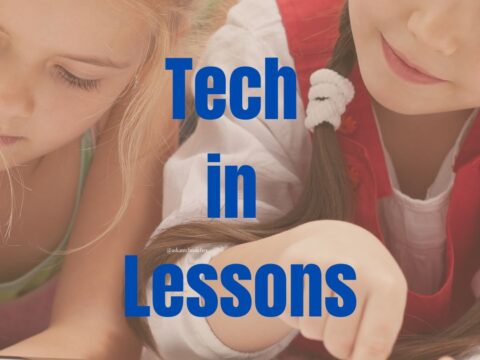 It’s summer, that time of rest and rejuvenation, ice cream and bonhomie. Like the American plains or the African savannas, it stretches endlessly to a far horizon that is the Next School Year. It represents so much time, you can do anything, accomplish the impossible, and prepare yourself quintessentially for upcoming students.
It’s summer, that time of rest and rejuvenation, ice cream and bonhomie. Like the American plains or the African savannas, it stretches endlessly to a far horizon that is the Next School Year. It represents so much time, you can do anything, accomplish the impossible, and prepare yourself quintessentially for upcoming students.
So what are the absolute basics you should learn this summer that will make a difference in your class in the Fall? Here are fifteen ideas that will still leave you time to enjoy sunsets and hang out with friends:
Learn how to handle basic tech problems
You probably know the most common tech problems faced last year (like hooking digital devices to the school WiFi, this list you might face running a tech-infused lesson, or this one students might face using technology). These are collected from students when they tried to use tech for class projects, parents when their children couldn’t finish their homework because of tech issues, and members of your grade-level team who wanted to use tech for a lesson plan but Something Happened. Know how to solve all of them. If you need help, add a comment at the bottom. I’ll give you some ideas.
Don’t be afraid to fail in front of students
There’s a lot to be learned from failure. Show students how you handle when your best efforts don’t work. Here’s more detail on how students learn from failure.
Don’t feel like you have to know the answer to every question
In fact, you can’t. There are too many. Remind students that most webtools and software are similar to others they already use–tools, toolbars, screen layout, and keyboard shortcuts to name a few. Review problem-solving strategies that students can rely on (like ‘How did you solve this in the past’).
Annotate a PDF
One of the many benefits of using digital textbooks rather than print is that users can write in them. Become comfortable with both the native tool included with the ebook and other options students might use at home or during research like iAnnotate, Notability, and Acrobat. Don’t forget to show how to delete these notes as part of cleaning up the text for next year’s students.
Submit homework digitally
Most schools celebrate Earth Day. Next year, incorporate it into your classroom management by asking students to submit their work electronically. This could be by sharing it with you, posting it to a class blog, embedding it into a Discussion Forum, or uploading it to their digital portfolio. This not only makes submitting work painless (and less likely to get lost) when submitted to a public forum, students benefit from each other’s knowledge.
Know where files are saved
This sounds easy, but many students–especially youngers–don’t know where their files are saved. If you’re in the file storage area, look at the bar at the top of the screen that shows the file’s full path–where you are in the file structure.
The top image above is from Google Drive; the second from Windows Explorer. Read this left to right, starting at the file’s root location and then drilling down into the file folders. Know how to find that location whether it’s in ‘My Documents’ or a server file like ‘Your.Name’.
Surprisingly, I know a lot of teachers who save everything to their desktop because they don’t know where else to save it–or how to do that. Not only is that confusing, it’s not safe. Anyone who has access to these teachers’ computers can access all of their files. Fix that this summer. Set up a ‘save’ folder on your computer, where you’ll save everything. Make file folders under it if you feel adventurous. Get used to saving here. It won’t take long and you’ll be happy you did.
Know how to backup data (and where it’s backed up to)
This is a total geek if you’ve never tried it, but simple if you have. You drag-drop folders (or copy-paste) to your backup location (like a removable hard drive or a USB device). If your school backs up files automatically, find out what the process is, which files are included, and where this backup is found. It probably won’t include files from your local drive (the hard drive of your personal device), but will include those on school servers. Know what they are so you save important files there.
Know how to use the digital devices available in your class
Your school probably uses a variety of hardware (laptops, iPads, Chromebooks, iPods, and more) to access cloud-based class websites, blogs, online grade books, and/or an LMS (like Otus, Google Classroom, or Edmodo). These are all fundamental to managing classes and providing web-based access. If you aren’t already comfortable in those environments, change that this summer. Try lots of activities in the hardware your students use. Post enough blogs and webpage articles that you know how to do it and can use it effectively the upcoming school year.
Have a Plan B if tech doesn’t work
Why? Because one of your greatest worries is that the tech you plan to use won’t work. Know what to do if that happens and then don’t worry anymore. Most webtools work fine. They only break if the entire website breaks (which is unlikely with well-respected tools). Plan B is likely to be as simple as having a different webtool that will accomplish the same goals.
Minimize your chances of needing a Plan B by running through the tool and using only those that are vetted by your IT folks or your PLN.
Be flexible
If you ask students to demonstrate their knowledge with technology, be open to their suggestions. They may love a tool you’ve never used before. Let them ‘sell’ you on its good fit with your project and then let them use it. After all, it’s not about the tool; it’s about the Big Idea and sharing their knowledge.
Model good digital citizenship
Always practice good digital citizenship. Cite sources; don’t use illegal media; treat online individuals respectfully. Insist your students do the same. When you use online resources, take a moment to ask students why it’s legal for you to use it. For example, if you use Google images in the classroom, let students know this is legal because of the concept of ‘fair use’–and explain what that is.
Empower yourself
Instead of blaming your administration for not providing professional development, search YouTube for webinars. Rather than whining because a solution someone gave you didn’t work, Google it. There are lots of education video collections designed to answer the most common education questions. Model this behavior for students–that you are inquisitive with a bias for seeking answers.
Expunge “This is the way we do things” from your vocabulary
Know why every action is the right choice or change it.
Technology is a tool–not a goal
Don’t use technology because it’s cool; use it because it enhances the lesson. If it doesn’t, move on to something that does. I know; it’s tempting to use that glorious new 3D printer for, well, anything, but take time to find a lesson plan it will support and roll it out that way. Students will find more value if they see why it’s important to their learning.
Build your PLN
Attend TwitterChats like #edchat or #csk8 or any other that interest you. Learn from others and share your knowledge.
***
Does it sound like a lot to do? Print this list out; post it by your computer. Any chance you get to retrain your habits, take it. You’ll be surprised how easy it is.
–first published on TeachHUB
Jacqui Murray has been teaching K-8 technology for 20 years. She is the editor/author of over a hundred tech ed resources including a K-8 technology curriculum, K-8 keyboard curriculum, K-8 Digital Citizenship curriculum. She is an adjunct professor in tech ed, CSG Master Teacher, webmaster for four blogs, an Amazon Vine Voice reviewer, CAEP reviewer, CSTA presentation reviewer, freelance journalist on tech ed topics, and a weekly contributor to TeachHUB. You can find her resources at Structured Learning. Read Jacqui’s tech thriller series, To Hunt a Sub and Twenty-four Days.





































